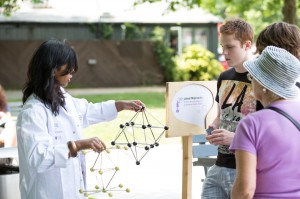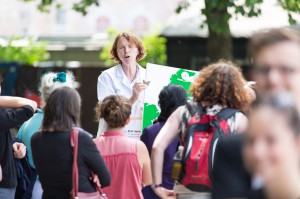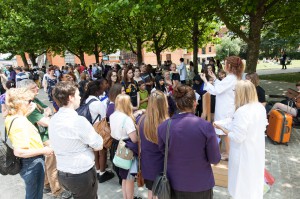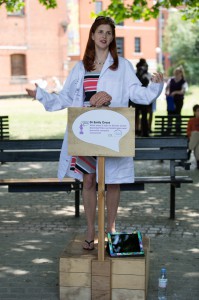 Dr Kami Koldewyn (KK) is a lecturer in the School of Psychology at Bangor University, and of the our Soapbox Science (SS) speakers for the Swansea event this Saturday. Her field of research is neuroscience, with a specialty in disorders of social perception and cognition. Before the event, Kami here provides a short introduction to her work, career path, motivations and vision for the STEM community. Meet her this 5th of July, on the Swansea Bay (next to the 360 Beach and Watersports centre and café).
Dr Kami Koldewyn (KK) is a lecturer in the School of Psychology at Bangor University, and of the our Soapbox Science (SS) speakers for the Swansea event this Saturday. Her field of research is neuroscience, with a specialty in disorders of social perception and cognition. Before the event, Kami here provides a short introduction to her work, career path, motivations and vision for the STEM community. Meet her this 5th of July, on the Swansea Bay (next to the 360 Beach and Watersports centre and café).
SS: Kami, very nice to meet you! And thank you for joining us for Soapbox Science Swansea. Tell us first a bit about yourself – how did you get to your current position?
KK: Well, my journey to becoming a scientist in the UK is a bit convoluted. I always loved science, especially anything to do with biology and chemistry — but as a child I wanted to be a veterinarian, then later a paediatrician. In University I simultaneously became disenchanted with the medical profession and re-found my love of music, resulting in my doing a double major in Music and Philosophy while completing the pre-med courses. By the end of University (at Pomona College in CA), I had decided to become either a musician, or (in the likely event of that not working out), return to graduate school after a few years to get a degree in aesthetic musicology. In the meantime, I entered the “real world” and worked with children and adolescents with special needs. Those jobs ran the gamut from working in a locked facility for emotionally disturbed teenage mothers, to working as a 1:1 aide for children with neurodevelopmental disorders and physical impairments, to eventually becoming a curriculum and assistive technology “consultant”.
It was in my work with those children where the seeds of my current scientific interests can be found. As an educator, I felt we were failing children with special needs because we simply did not have enough knowledge about neurodevelopment in general, let alone about how development might be altered for those with neurodevelopmental disorders. I found I wanted to know the answer to questions like: How do the minds and brains of children with neurodevelopmental disorders differ? Do they perceive and understand the world differently? Do they learn differently? How can we use the understanding we gain about those differences to help them learn and thrive? The more I thought about these questions, the more I wanted to be one of the people researching those questions rather than waiting for others to do the necessary scientific work. Unsurprisingly, though, making the switch to science took a little bit of doing. Because I hadn’t majored in a science, I needed to take courses in upper-level biology, neuroscience and psychology at night [molecular cell biology was so much fun I almost got distracted from neuroscience]. And because of my lack of experimental experience, even after the night courses I had to apply to graduate school more than once. My persistence DID pay off, though, and after I entered a PhD program in neuroscience at UC Davis, the rest was pretty straightforward. After finishing the PhD I spent four years at MIT doing postdoctoral work in a great lab and started looking for a permanent position. The perfect job in a great psychology department just happened to be in a different country. And that’s how, after a lot of exploration, I allowed life to bring me to science and then allowed science to bring me to beautiful North Wales. I’m in my first year as a lecturer at Bangor University and I sure hope I can figure out how everything works here, because so far I am absolutely loving it.
SS: Who inspired you to get a career in science?
KK: In truth, a whole host of characters have been inspirational to me in choosing a career in science –first and most importantly, both of my parents.
My dad is a physicist, and the kind of person who gets misty-eyed over the beauty of equations. All through my childhood, he engaged my brother and me in all sorts of science. We devised what we thought were cunningly clever experiments with prisms, weights and pendulums. We grew crystals. We allowed jars of pond water to become really nasty so we could peer at hundreds of tiny creatures through our microscope. We grew vines in different lighting conditions (and on platforms that rotated at different speeds) because I thought we could confuse the plants into twining in the opposite direction (I was wrong). In high school, my dad and I spent hours (and created a large spot on the family room carpet) building a cloud chamber together. To my dad, I owe a lot of my hard-to-suppress tendency to say, “huh, I wonder how that works” in response to almost everything. I thus also blame him for my well-known inability to ignore “shiny” new research projects when I should be “focusing”.
My mother, though, is not a scientist with her head in the clouds, dreaming of experiments. She is organized and pragmatic and good at planning (sadly, all traits I did not inherit – and boy would they all be helpful in an academic career!). And she is also a tremendously brilliant teacher. She is the sort of firm but fair teacher that all the “bad” kids secretly respect and look up. And she loves to teach. It is mostly due to her influence that I wanted, as a scientist, to also be an academic. I wanted the science, but I also wanted the chance to teach and mentor. She may not have influenced me towards science, but she inspires me to want to inspire others.
And, throughout my academic work, I’ve had great mentors – people who not only helped me learn how to do good science, but also the kind of people that let me see that I could someday have something significant to contribute. There was Mr Walker, tasked with teaching the basics of physics and chemistry to 13 year-olds, and for whom my great friend Veronica Hubeny (now a Reader in quantum physics and mathematics at Durham University!) and I wrote tortuously long and ridiculously funny lab reports. Dr. Rachel Levin at Pomona College, who sparked my interest in neuroscience through her work in bird song. Dr. Susan Rivera, who encouraged me in combining my interests in neurodevelopmental disorders with my fascination with neuroscience. Dr. David Whitney, who turned me into a vision scientist, taught me psychophysics and always told me not to doubt myself. Dr. Randi Hagerman, whose sheer enthusiasm for understanding, supporting and simply enjoying children with neurodevelopmental disorders is infectious. Dr. Nancy Kanwisher, who encouraged me (sometimes gently, sometimes no so gently) to remove prevarications from my writing and my collaborations and to never settle for anything less than excellent science.
And finding scientific mentors will probably never stop for me. There are so many really excellent people in the field – all with unique perspectives and insights. I see no reason to stop learning now.
SS: What is the most fascinating aspect of your research?
KK: The most fascinating aspect of my research is being able to use a variety of different techniques to get a window into how the mind and the brain work. Especially, I enjoy trying to learn how brain processes change across the life-span, especially during childhood. The brain is complex and fascinating and constantly changing and getting a clear picture of how it works, even for seemingly simple tasks, is fiendishly difficult. But of course, that’s also what makes studying it so much fun.
SS: So what attracted you to Soapbox Science?
KK: I believe that almost everyone is actually a scientist at heart, even if they don’t realize it. All people wonder how the world works, what the human mind contains and what will happen if they mix two substances together. Somehow, though, science has gained a reputation as “hard” and scientists as “unapproachable”. That’s not to say that science isn’t hard or complex (or, ahem, that some of us aren’t socially a little awkward), but asking scientific questions and understanding scientific findings shouldn’t be hard. Soapbox science seemed like an opportunity to talk to non-scientists about the science that I find fascinating, and encourage them to tap into their own inner “scientist” to ask the questions they’ve always harboured about the world around them. Soapbox science is also an event that supports speakers; helping us to learn how to communicate the sometimes complex things we study to people who haven’t been thinking about them for years. And, the fact that soapbox science is specifically geared to raise the profile of female scientists was of particular interest to me – too many of the young women I’ve met believe that they aren’t “smart enough” to become scientists. The more those young women see ordinary, run-of-the-mill women like me out in the world as scientists, they more they will realize that they, too, could become scientists. Because really, who doesn’t want to become a scientist? We have all the fun.
SS: Sum up in one word your expectations for the day – excitement? fear? thrill? anticipation?
KK: One word? Really? I never use one word when 26 will do. Slightly-terrified-anticipation (just pretend it is a compound word in German).
SS: And if you could change one thing about the scientific culture right now, what would it be?
KK: I would like to see an increase in the community recognition and institutional “rewards” for a diversity of contributions to academic science. This diversity shouldn’t just come from a diversity of genders and races but also from a diversity of different backgrounds, perspectives and skill-sets. Excellent science should not have to be a solitary pursuit. In the current system, scientists are expected to be good at everything. We are expected to be bordering-on-genius thinkers capable of coming up with brilliant new questions, great at designing experiments, good writers, good speakers, computer programmers, statisticians, teachers, mentors, and even administrators. The fact is, though, that few of us are excellent at all of that. We’re lucky if we’re truly great at any 2 or 3 of them. For a lot of us, this means that we spend too much time thinking about how incompetent we are and not enough time thinking about how we can collaborate with others whose skills complement ours. We’re encouraged to be solitary and “independent” – but in truth, if we want good science, we should be not only willing to collaborate, we should be truly happy to do so. Brilliant solitary scientists should get lots of recognition – but so should good collaborators and good mentors and good teachers and people who are good at communicating about science to non-scientists. ALL of those things are important for good science in the world – not only because it is more efficient than all of us struggling along by ourselves but also because most enterprises benefit from a diversity of thought. No one should do those things only because they’re rewarded – but I’d sure like to see the system start to change so that the scientific community (and university administrations) recognize all great contributions that move science forward.
SS: And finally, what would be your top recommendation to a female PhD student considering pursuing a career in academia?
KK: Find multiple mentors. Very few people are the perfect mentor in all aspects of science or academia or surviving the scientific world. But there are many people who have lovely, brilliant things to teach you in at least one area. Ask people for support and you will be surprised by how many people are genuinely charmed to be asked, even surprised that they are considered to have the expertise or authority. People generally want to connect and want to help – it can be super hard to ask, but you’ll rarely be sorry when you do.

 I’m a scientist on a mission to get Wales passionate about science and engineering. I run a Cardiff-based social enterprise called science made simple taking science to people all over the UK (and to 27 countries overseas so far!). Just like Soapbox Science, we want to try and reach those who wouldn’t normally attend a science festival or a museum. But I have to say I sometimes worry about education in Wales, and the effect some devolved decisions could have on the scientists and engineers of the future.
I’m a scientist on a mission to get Wales passionate about science and engineering. I run a Cardiff-based social enterprise called science made simple taking science to people all over the UK (and to 27 countries overseas so far!). Just like Soapbox Science, we want to try and reach those who wouldn’t normally attend a science festival or a museum. But I have to say I sometimes worry about education in Wales, and the effect some devolved decisions could have on the scientists and engineers of the future. One of the biggest indicators of whether a student will choose to go on to study science at a higher level is whether they are taught by a specialist science teacher. In Wales we are facing a crisis at both ends of the pipeline. A
One of the biggest indicators of whether a student will choose to go on to study science at a higher level is whether they are taught by a specialist science teacher. In Wales we are facing a crisis at both ends of the pipeline. A  Our speakers are all women who are actively researching a huge range of topics within science, technology, engineering, maths and medicine. You can expect to hear about everything from how cells work to how stars are formed, and everything in between.
Our speakers are all women who are actively researching a huge range of topics within science, technology, engineering, maths and medicine. You can expect to hear about everything from how cells work to how stars are formed, and everything in between. Why just women? It won’t surprise you that science suffers as much from the gender-biased leaky career pipe as any other demanding career. Girls love science at school, and up to 60% of science undergraduates are women; yet only 15% of UK science professors are women. This means around 45% of the scientists trained and nurtured by the UK’s education system are being lost from the career ladder. Soapbox Science is born from the hearts of active female scientists who are deeply concerned about the loss of excellence from the women of the UK’s science community.
Why just women? It won’t surprise you that science suffers as much from the gender-biased leaky career pipe as any other demanding career. Girls love science at school, and up to 60% of science undergraduates are women; yet only 15% of UK science professors are women. This means around 45% of the scientists trained and nurtured by the UK’s education system are being lost from the career ladder. Soapbox Science is born from the hearts of active female scientists who are deeply concerned about the loss of excellence from the women of the UK’s science community. We always aim to have a wide variety of disciplines represented, with biologists, astrophysicists, medical researchers and climate scientists all on the line up, plus a whole lot more. We also aim to have a good spread of different career levels, so you could be hearing from a PhD student about their own research project, right up to a Pro Vice Chancellor who leads several research teams and a university!
We always aim to have a wide variety of disciplines represented, with biologists, astrophysicists, medical researchers and climate scientists all on the line up, plus a whole lot more. We also aim to have a good spread of different career levels, so you could be hearing from a PhD student about their own research project, right up to a Pro Vice Chancellor who leads several research teams and a university! On the day, we set up 4 Soapboxes in a busy location like a riverside path, public park, town square or even the beach, and our engaging speakers and team of helpful volunteers draw in a crowd. The great thing about Soapbox Science is that it gives members of the public, who might not otherwise have set out to hear about science, the chance to meet, chat and engage with researchers in person; our feedback tells us that they really enjoy the experience!
On the day, we set up 4 Soapboxes in a busy location like a riverside path, public park, town square or even the beach, and our engaging speakers and team of helpful volunteers draw in a crowd. The great thing about Soapbox Science is that it gives members of the public, who might not otherwise have set out to hear about science, the chance to meet, chat and engage with researchers in person; our feedback tells us that they really enjoy the experience! Our events are also super simple and resource-light. Some wooden Soapboxes, branded lab coats for speakers and t-shirts for volunteers, and a few carefully chosen props. No microphones, no screens, no projectors, no posters – just our hand-picked speakers who are experts when it comes to sharing their passion for research.
Our events are also super simple and resource-light. Some wooden Soapboxes, branded lab coats for speakers and t-shirts for volunteers, and a few carefully chosen props. No microphones, no screens, no projectors, no posters – just our hand-picked speakers who are experts when it comes to sharing their passion for research.


